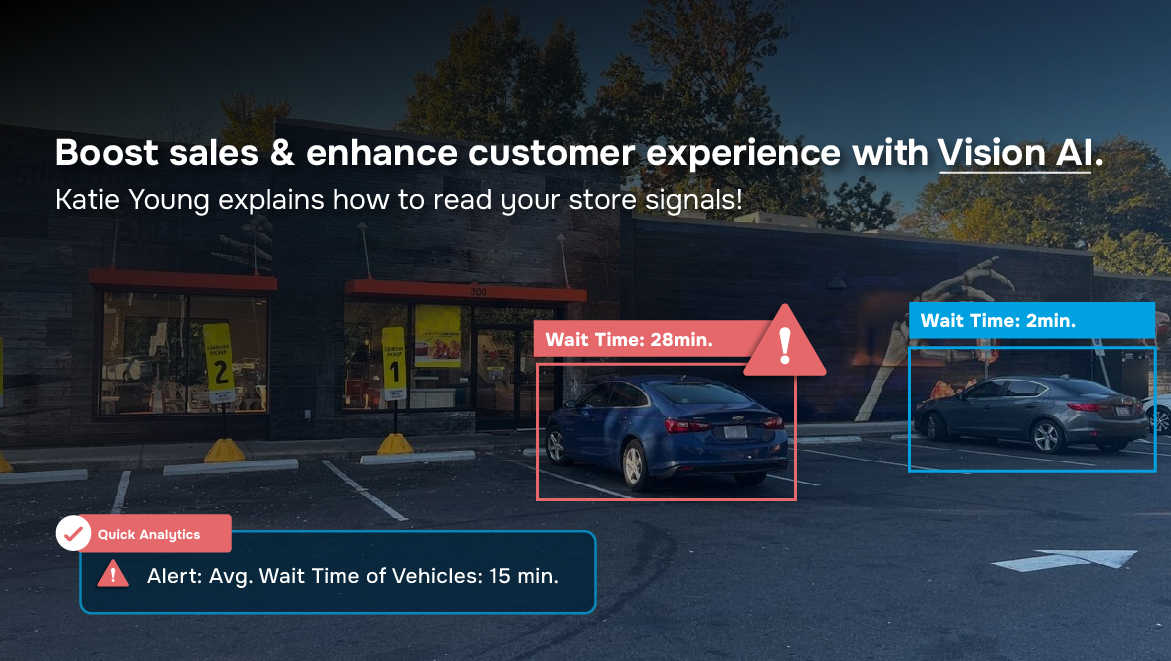
Vision AI in Restaurants: Signals That Drive Faster, Smarter Operations
As I have taken some time off and mostly spent it with family, I have also had the opportunity to spend time with companies on the forefront of what is possible in the intersection of AI and retail. I have been connecting with the folks at Nova, and I’m excited to see firsthand what’s possible when you build AI-native systems. I wanted to share some thoughts on the future of Vision AI and potentially start a conversation.
Unlocking Store Efficiency with AI
In today's retail, the real challenge is seeing what’s happening in your stores. I probably use the adage “you can’t manage what you can’t see” too often, but it still rings true. Store signals—real-time metrics like customer footfalls, wait times, drive-thru throughput, inventory levels, and order processing speeds—are the heartbeat of operations. Vision AI empowers operators to harness these signals seamlessly, turning raw data into actionable strategies.
Until recently, store signal data relied on error-prone manual counts or basic sensors, limiting real-time responsiveness. Vision AI revolutionizes this by deploying machine learning-powered cameras to process visual data instantly, offering precise insights without invasive tracking. When integrated with a platform like Nova's AI-driven ecosystem, operators gain a lightweight yet powerful toolset to act on these signals, driving efficiency and profitability. Imagine being able to see instantaneously when something is ‘wrong’-- when a store is understaffed, showing signs of distress or fraud, or showing opportunity for more sales.
Tracking Customer Footfalls: Gauging Traffic and Optimizing Layouts
Customer footfalls—tracking how many people enter, exit, or navigate a store—provide critical insights into demand and behavior. Vision AI uses object detection to count individuals accurately, even in crowded settings, while generating heatmaps to visualize movement. By correlating footfalls with external variables like promotions or time of day, predictive models help operators adjust staffing and layouts proactively, maximizing upsell opportunities, minimizing overstaffing costs during lulls, and ensuring service during rushes.
Monitoring Wait Times: Enhancing Service Speed and Customer Experience
Every operator knows that wait times at checkouts, service desks, or kiosks are make-or-break for customer satisfaction. Excessive delays drive abandonment rates as high as 30% in busy settings. Vision AI tackles this by using pose estimation to detect queue formation and anonymized facial tracking to measure dwell times, all while prioritizing privacy. For a hospitality chain, this extends to optimizing table turnovers, balancing speed with guest comfort. Predictive algorithms anticipate surges, enabling preemptive adjustments. The result? Faster service boosts Net Promoter Scores (NPS), fostering loyalty, while efficient resource use trims overtime costs, building a leaner, more profitable operation.
Optimizing Drive-Thru Operations: Speed and Accuracy on the Go
Drive-thrus often account for 50-70% of revenue for quick-service chains, making throughput a critical signal. Vision AI monitors vehicle queues, counts cars, and estimates wait times using edge-computing cameras, ensuring real-time accuracy. For instance, detecting a short queue might trigger a suggestion like, "Add a dessert for $1?"—increasing order values by 20%. By analyzing patterns across thousands of transactions, operators fine-tune staffing and workflows, boosting throughput by 25-30% while reducing errors and customer complaints, directly enhancing profitability.
Inventory Tracking: Preventing Stockouts and Shrinkage
Inventory signals—stock levels, shelf organization, and product movement—are vital for balancing supply with demand. Vision AI automates this by scanning shelves with image recognition, identifying low stock or misplaced items instantly. Real-time alerts for restocking and anomaly detection reduce shrinkage by up to 40%. By linking inventory data with footfalls and sales, AI refines reorder predictions, ensuring high-demand items are always available without overstocking. For a large chain, this minimizes capital tied up in excess inventory while preventing lost sales from stockouts—driving profitability through precision and efficiency.
Streamlining Order Times: From Placement to Fulfillment
Order times—from placement to handover—are a key efficiency metric. Vision AI breaks down each step, using activity recognition to time tasks like prep or packing across stations. Benchmarking performance against historical data pinpoints slowdowns—like a congested prep line—and suggests workflow tweaks. For a quick-service restaurant, this could mean retraining staff on high-demand tasks or resequencing orders to cut delays. The outcome? Higher revenue per hour and leaner operations, amplifying margins across the board.
Nova Vision AI: Empowering Signal Analysis
Vision AI's strength lies in its ability to capture and interpret store signals in real time, and Nova's Vision AI platform takes this to the next level. Built by former Tesla engineers, Nova integrates multi-camera processing (MCP) tools with a unified data hub, automating signal analysis across diverse retail environments. From customer footfalls to drive-thru queues, Nova's AI-native architecture processes terabytes of visual data to deliver predictive dashboards, enabling operators to act instantly—whether optimizing layouts or preempting bottlenecks. Scalable from single stores to enterprise chains, Nova's seamless deployment ensures retailers can harness these insights without complex retrofits, subtly empowering smarter decisions and higher profits.
Building a Profitable Future with Vision AI
The future is going to be driven by AI solutions, but they can be overwhelming to implement in a complex retail environment. The good news is it doesn’t have to be all or nothing. The trick is to start by analyzing ‘signals’ (whatever matters most to your business) and building the path from there. Personally, I’ve been excited to see what Nova is doing, and I'm curious to see what everyone else is seeing in this space.


.png)



